The tree tube problem
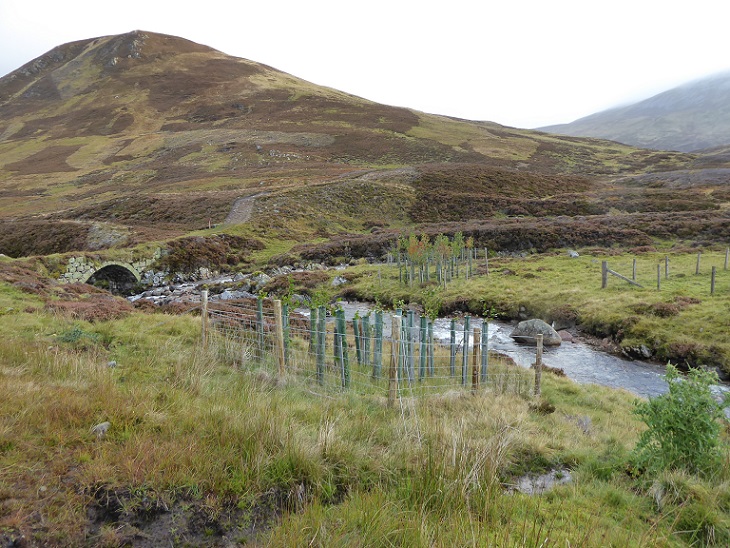
The theme of the Spring/Summer issue of Reforesting Scotland was climate change. It ended with an excellent piece by a forest manager, Willie McGhee, on “Seas of plastic in the countryside”. His guesstimate is that in Scotland we may have used 200 million plastic tree tubes in the countryside over the last 40 years. His concern was the environmental cost of this plastic, that little is recycled and that much of it will ultimately end up in the world’s oceans.
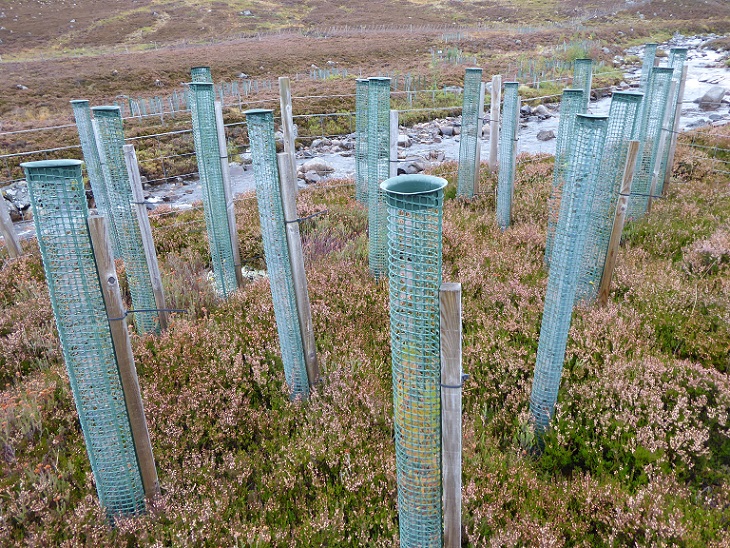
Willie McGhee could have added that since plastic products are derived from oil, every tube that is used reduces any benefit that tree planting has as a means of locking up carbon and mitigating climate change. Where the tree dies, the impact of the plastic tree tube in terms of carbon accounting is completely negative.
There is one reference to tree tubes in the UK Forestry Standard, all 232 pages of it (see here),and that is not about their impacts. That standard is not fit for use in Scotland, let alone our National Parks, yet the Loch Lomond and Trossachs National Park adopted it lock, stock and barrel in its Trees and Woodland Strategy last year.
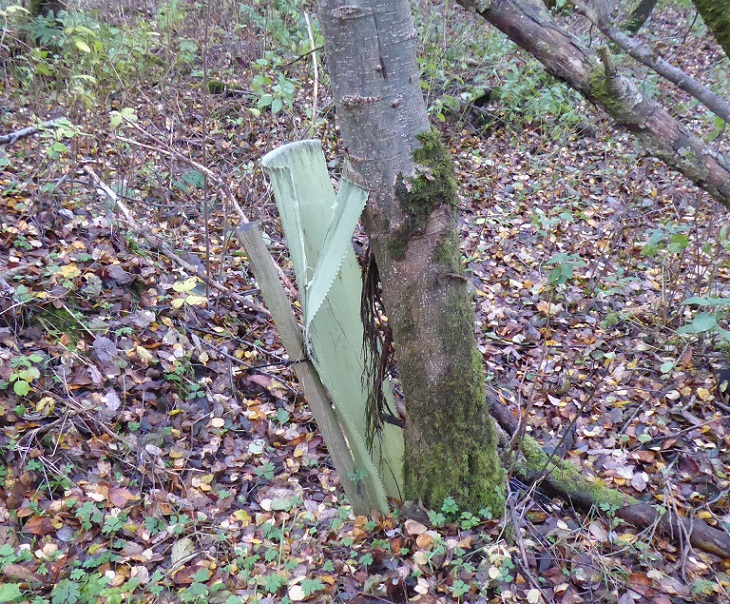
Currently, most plastic tree tubes are left forgotten in the countryside. That is why Willie McGhee’s piece, he is also a member of the Forest Policy Group, was so welcome. He covered some of the costs and challenges of recycling on the premise that we shouldn’t be allowing tree plastic to litter the countryside .
Recycling, however, is unlikely to solve the problem even it was made a requirement for all woodland planting. First the recycled plastic would need to be recycled into something nonpolluting. Plastic at present commonly gets recycled into our clothes which just delays the time it takes for it to get into our oceans (see here)).
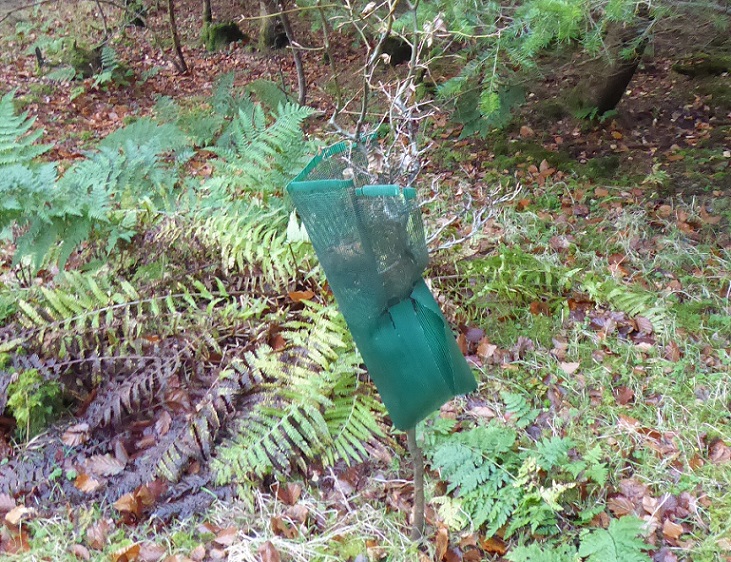
Second, the lifetime of tree tubes varies considerably, with some becoming redundant or damaged almost immediately, while others last for years. To prevent broken off bits of plastic entering soils and river systems there would need to be regular clear-ups. The costs of that would be phenomenal.
The best and only effective solution is to stop using plastic tree guards. That means either the forest industry starts using tree tubes made from biodegradable materials or, better, they start questioning what it is about ecological processes and forestry systems in Scotland that has led to such widespread use of plastic tree guards and address those issues. Our two National Park Authorities, with their statutory duty to promote nature conservation, should be taking a lead here. Unfortunately, up until now they have formed part of the problem. I will illustrate this with two examples.
The Pearls in Peril project
Parkswatch has commented on the postage stamp planting around Glen Shee (photos above) and Balmoral on a couple of occasions in the last year (see here) and (here). This planting formed part of the Pearls in Peril Project. After David Attenborough’s Blue Planet the use of plastic tree guards along watercourses now looks unwise, to say the least. How, therefore, did this well-intended conservation project end up doing something damaging to the natural environment?
Pearls in Peril (PiP) (see here) was a UK wide project, funded by the EU LIFE programme, which was targeted at “saving” the freshwater pearl mussel. It ran from 2012-17 and included a wide range of actions in rivers across Scotland. The Dee catchment in the Cairngorms was just one river system among several and the postage stamp planting just one action among many (see here). One of the key objectives of the PiP project was to increase levels of riparian woodland in areas where the freshwater pearl mussel survived. Research has shown this could help the freshwater pearly mussel by mitigating the impacts of global warming and rising water temperatures, stabilising river banks and reducing the amount of silt flowing into them and providing more food for salmonids which young freshwater pearl mussels use to hitch a lift.
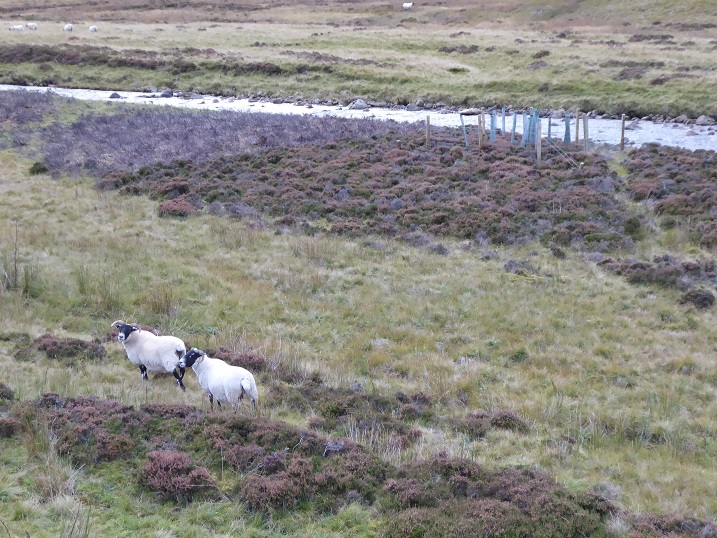
The problem the project faced in that Dee catchment was that much of land was owned by private landowners and used for sporting purposes. While I have no insight into what negotiations took place, the evidence on the ground is clear. Landowners like Invercauld did not want to give up land used for grazing, whether by sheep or deer, or for grouse shooting. The project was therefore reduced to postage stamp planting. It is likely that those working on the Pearls in Peril Project had to sweat an arm and leg even to achieve that.
Having secured agreement to small pockets of woodland, the problem then was how to protect them from grazing. Given muirburn and overgrazing, they would be likely to attract deer from miles around. Hence the high plastic tree guards although, as has been observed, when trees do pop out the top they are the perfect height for deer to browse without bending their necks!
A deer fence round each pocket – as originally was done at the Loch Garry tree planting scheme years ago – might have addressed the issue but would have had a much larger landscape impact, been more expensive and wouldn’t have addressed the “problems” caused by voles whose numbers tend to increase dramatically as soon as grazing pressure from larger herbivores reduces. On land that has been turned into grouse moor, there is almost nothing left to eat them. Mammalian predators such as foxes, stoats and weasels are treated as vermin and relentlessly persecuted. Alongside this, the design of the pockets would make it almost impossible for kestrel and short-eared owl, to hunt. Imagine an owl trying to descend on a vole through this thicket of tubes without garrotting itself on the fence!
The Cairngorms National Park Authority rightly has rightly committed in its National Park Partnership Plan to landscape scale conservation but ends up doing postage stamp conservation with damaging consequences. Good intentions end up achieving the opposite. The explanation for this failure lies in the power of landowners and is why land reform is central to conservation issues in our National Parks.
Plastic tubes and planning
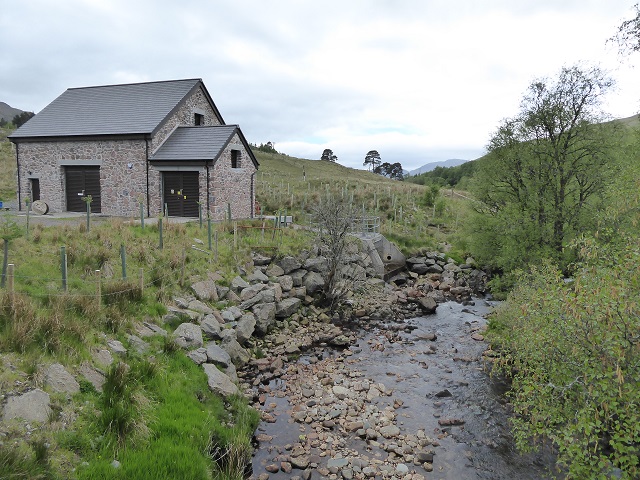
Both our National Parks are committed to increasing areas of native woodland and, powerless to tackle landowners, the main way they have done this is through the planning system. Planting native trees has become almost a precondition for getting developments in the countryside approved. Indeed, as was demonstrated by the Loch Lomond and Trossachs National Park Authority’s discussion of the Hunter Foundation Planning Application at Ross Priory (see here), it often appears that as long as a developer promises to plants native trees, any development will be found acceptable.
At present the way these planning conditions are worded promotes the use of plastic tree tubes and contain no provisions for their removal. For example the proposed condition for Ross Priory stated:
“17. Detailed Landscape Planting Scheme: The development hereby approved shall only take place in accordance with a Detailed Landscape Planting Scheme which shall be submitted………………and in addition shall incorporate the following information:
……………………………………….
d. Planting methods and measures to ensure establishment of all planting;”
Since plastic tree tubes and fencing are much cheaper than sorting out the underlying problems which stop trees from regenerating naturally, their use is effectively being promoted by the planning system. What was no doubt originally well-intentioned now appears almost recklessly stupid. Our National Park Authorities could and should stop plastic guards being used in any tree planting promoted by the planning system.
The implications for conservation in our National Parks
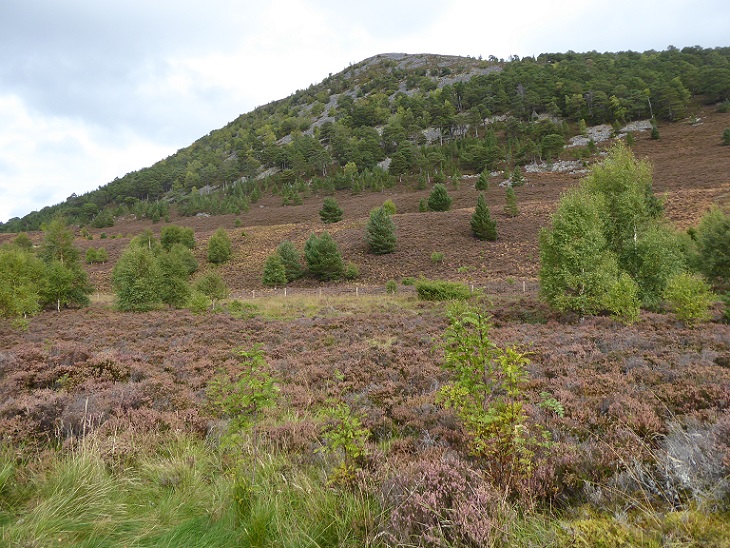
The wider lesson from the damaging use of plastic tree tubes is that conservation measures, like conservation projects, should not be developed in isolation but need to consider the environment as a whole. We need landscape scale conservation, as at Glen Feshie, not environmental tinkering.
These plastic guards are also harmful to the trees and don’t “split” like should. Countless of them also rot inside the tubes and they harbour funguses , moulds and parasites. They are rubbish and impossible to remove either easily or sensibly in terms of environment. They are environmental hooliganism and irresponsibility
moving away from the good/bad dichotomy….
tree guards can be used several times sequentially, to spare the growing tree and reduce plastic use.(best to use e.g. netlon, with staples only two thirds in, so easily extracted and reusable)
the benefits of establishing these small plots, in addition to those claimed for the pearls in peril project, are that they demonstrate where trees can/not grow, in an otherwise treeless landscape,(as was shown at loch garry) and they will provide a seed source decades hence, when browsing pressure may have been reduced.
of course, reducing browsers, reintroducing apex predators, etc., may also do the trick, so by all means argue that case..
but meantime, we do what we can, and work with what we’ve got. anything else is a counsel of perfection.
What alternatives does anyone suggest. Biodegradable means deer and sheep will eat them. Anyone tried a long lasting chilli flavour ? Deer fencing is too expensive for nearly all projects like this and deer get in when there is deep snow.
Managing tree tube “waste” is specifically referenced in U.K. Woodland Assurance Standard 3.6.2 http://ukwas.org.uk/standard/3-woodland-operations/#section-6
See also:
https://tubex.com/tubex-collection-and-recycling-programme/
Thanks Andrew, this is significantly better than the UK Forestry Standards requiring waste to be removed. There is a reference to the UKWoodland Assurance Standard in both the CNPA Forest and the LLTNPA’s Trees and Woodland Strategies but the emphasis is on the UK Forestry Standards. There is no mention of tree tubes at all in the LLTNPA Strategy, one in the CNPA’s and that is to their short-term visual impact.
Why anyone would consider plastic, when 100%. Biodegradable paper alternatives could be made is utterly beyond me! Plastic ones should and could be outlawed immediately! Why this has not been done over the last 50 years goodness only knows!
Thanks for the mention of the Loch Garry Project. More can be read about the approach taken in the face of conflicting land use priorities at http://www.andywightman.com/archives/3291 and the introductory paper outlining the planting techniques used can be found at Scottish Forestry Vol 33 No1 January 1979 pages 37-44
‘A Tree Planting Trial at Loch Garry (Tayside Region) Aimed at Habitat Improvement for Fish’
It is all qite a complex issue. protective tubes are good at protecting trees from things like rabbits. However, when the tree growth emerges at the top, roe deer in particular find it just the right height for a nice browse – saves all that bending for grass etc. I have seen many plantings fail due to this. That is presumably why the photos of group plantings show they are both fenced off and tube protected.
Regarding the benefit to pearl musssel, as far as I understand, the issue centres around rising water temperatures which are prdiccted to rise above the maximum at which trout and salmon spawn, pear mussel spawn spend part of their life cyclle in these fish and hence rising water temperatures threaten both. I recall looking at the efforts of somefishermen who were restoring two species to loch Neigh in nothern island and its feed streams.They bought up tanks from a cheese making company that was folding, rented an old quarrry site and set up a successful hatchery in which they placed pearl mussels in the entry flow to the tanks holding hatchlings so the larvae would infect the young fish which were later released into the local streams.
The plantings were intended to shade the water in the rivers like the Clunie and Gairn and hence limit water temperatures. To achieve this, extensive lenghts of the rivers must have their banks planted up. This would require long lengths of deer fences along banks on both sides. This would prevent the free passage of deer, among other things and deer forest owners would not agree. The small group plantings are justified on the grounds that the will suplply future seed .There is no evidence shortage of seed is a signifcant constaint.One birch tree produces enormous numbers of seed and they blow for miles. Its grazing that is the constraint.
Particularly infuriating seeing the feeble postage stamp plantings in Glen Clunie when there are in fact willows & alder juuuust managing to survive along the riverbank, albeit in a dwarfed state. A relaxation in browsing pressure is clearly the smartest, most effective answer but I wonder how long it’ll be before we start seeing any action on this from said estates.
Yes and by the path up Carn an Tuirc there is a lovely wooded gorge!
Overgrazing of vast tracts of montane and forest habitats in Scotland by red deer will not end so long as the Royal Family continue to manager deer on Balmoral as though Queen Victoria was still on the throne. They set the standard for most other estates but prolonged government effort, over most of the last 20 years, using voluntary control schemes as provided by the Deer (Scotland) Act 1996, have failed to reduce deer numbers on Balmoral to ecologically acceptable levels. That is why the Deer Working Group, set up by the Scottish Government, in its report last December recommended that Balmoral and its neighbours in the Caenlochan Special Conservation Area should be subject to Parliamentary investigation. Reducing deer numbers over large tracts of land, both at Caenlochan and elsewhere, will do far more for biodiversity restoration, flood control and climate change mitigation than post stamp conservation with plastic tubes and fences. Appropriate action by the Royal Family is long overdue.
Plastic guards are critical to enabling young trees to survive and thrive acting as mini greenhouses and providing protection from browsing animals, weeds and herbicides until the tree is fully established. Following many decades of tree planting up and down the UK, there are now millions of plastic tree tubes littering the landscapes, most of which are made from single-use plastic. These disintegrate into smaller fragments and find their way into the soils and waterways. With UK Government commitments to plant an extra 30 million trees a year, this problem will only get worse over time. There are biodegradable alternatives to the plastic tree guard, but none yet that are financially viable, compostable and can effectively protect saplings for the required amount of time. [Ed: comment then switches to project in Krajina]This project will remove redundant tree guards over 8 hectares for reuse or recycling, engage communities and volunteers in tackling the problem, and plant 7,000 trees in 5 woodlands to trial alternatives to the plastic tree guard. It will also seek a sustainable solution through sector-wide collaboration, disseminating conclusions and recommendations nationally at the end of the trial. Krajina area is home to a rich collection of different ecosystems such as canyons, valleys, hills, mountains, meadows, rocky cliffs etc. The main focus of the project is the climbing sites which are threatened by increasing number of visits by climbers following the publishing of a local climbing guidebook. Lack of paths and access to crags has led to destruction of habitat, including the removal of trees, moving of boulders, damage to the fragile vegetation and nesting birds on the rock faces, lack of designated BBQ and open fire areas which has led to uncontrolled wildfire and the leaving of litter, much of it plastic. Working with local climbing groups and other visitors, this project aims to educate visitors and locals about their behaviour in the wild, and to protect wildlife through the installation of signs to inform climbers to avoid nesting birds, plantingtrees, collecting the trash along m of approach path, and developing more obvious, fixed trails.
If they’re single use plastics then its a shame we can’t apply the same thinking as that introduced by WEEE for manufacturers of electrical goods – and require the manufacturers to provide ultimate disposal. Just like WEEE, I’m sure this would focus minds on an “economically viable” sustainable alternative.
The simple solution is to remove them no later than three years after planting. It should be a planning condition and enforced. Voluntary groups should be allowed to help in their removal. Also less is more, cosmetic planting should be ruled out and form part of new policy jurisdictions.